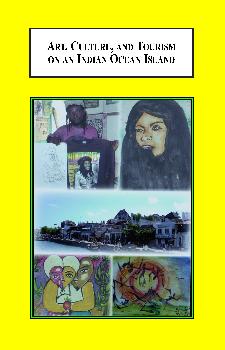Art, Culture and Tourism on an Indian Ocean Island: An Ethnographic Study of Jua Kali Artists in Lamu, Kenya

| Author: | Wright, Kristina Dziedzic | |
| Year: | 2010 | |
| Pages: | 200 | |
| ISBN: | 0-7734-3874-2 978-0-7734-3874-3 | |
| Price: | $159.95 + shipping | |
| (Click the PayPal button to buy) | ||
This book employs an ethnographic approach to understand the evolution of jua kali (Swahili for “hot sun”) art forms, especially in response to the international tourism industry. The importance of ethnicity to Lamu’s jua kali artists and the ways that ethnic identity is expressed visually in their artwork offers a unique approach to analyzing processes of cultural commoditization.
Reviews
“. . . this impressive book moves astutely from an analysis of the interactions of tourists and local artists, to considering the inter-ethnic relationships between groups in Lamu and postcolonial Kenya more broadly, to exploring the connections between African and African diasporic peoples and cultures.” – Prof. Krista A. Thompson, Northwestern University
“. . . a sensitive and nuanced study of how ethnic minority artists adapt to the challenges of survival by developing direct relationships with their customers. This richly illustrated volume contributes new understanding to the symbolic and methodological creativity of an authentic local art form that emerges from the vicissitudes of ethnicity, tourism and globalization.” – Prof. Rachel Reynolds, Drexel University
“. . . a compelling account of jua kali art in Lamu and its everyday realities through a careful ethnographic approach that includes participant observation, in-depth interviews, and consultation of secondary resources.” – Prof. Mwenda Ntarangwi, Calvin College
“. . . a sensitive and nuanced study of how ethnic minority artists adapt to the challenges of survival by developing direct relationships with their customers. This richly illustrated volume contributes new understanding to the symbolic and methodological creativity of an authentic local art form that emerges from the vicissitudes of ethnicity, tourism and globalization.” – Prof. Rachel Reynolds, Drexel University
“. . . a compelling account of jua kali art in Lamu and its everyday realities through a careful ethnographic approach that includes participant observation, in-depth interviews, and consultation of secondary resources.” – Prof. Mwenda Ntarangwi, Calvin College
Table of Contents
Foreword by Dr. Krista Thompson
Preface by Dr. Mwenda Ntarangwi
Acknowledgements
Introduction
Theoretical framework for research, background information about the jua kali sector in Kenya and the island of Lamu, and methodology that guided fieldwork.
Disparate Discourses on Art, Commodity and Cultural Otherness
The Art of Jua Kali
Developing Markets
Lamu: Geography, Demographics and Cultural History
Lamu as “Myth Factory”
Research Methods and Fieldwork
1. Culture as Commodity
Analysis of how culture is defined and commoditized in Lamu, and the effects of a touristic audience on the artwork created and sold there.
Definitions of Culture
Marketing Culture
Types of Tourists
Consumer Influence
2. Birds of a Feather
Examination of the central role of ethnic relations in Lamu society and the various ways that ethnicity is represented by the island’s informal sector artists.
Rasta Boyz
On Being Kikuyu
The Culture of Jua Kali
On Being Swahili
Adaptive Identities
3. Flocking Together
Ethnicity’s role in shaping the island’s sociocultural networks and effects on the making and selling of artwork.
Ethno-Geographic Layout of Lamu Town
Culture Group as Enterprise
An Exercise in “Copy-Right”
Masters and Apprentices
Systems of Distribution
The Lamu Environmental Art Youth Group Jua Kali Associations
4. Craft Depends on Materials
Use of materials in constructing culture and the creative reuse of found media in a challenging socioeconomic climate.
The Art of Recycling
The Art of Coconuts
Jua Kali Souvenirs
5. Conclusion
Evaluation of a special exhibition in Lamu in 2004 and analysis of the sociopolitical implications of the Culture Group’s artwork.
A “Representative Sample” of Lamu’s Art World
Final Reflections
Bibliography
Index
Preface by Dr. Mwenda Ntarangwi
Acknowledgements
Introduction
Theoretical framework for research, background information about the jua kali sector in Kenya and the island of Lamu, and methodology that guided fieldwork.
Disparate Discourses on Art, Commodity and Cultural Otherness
The Art of Jua Kali
Developing Markets
Lamu: Geography, Demographics and Cultural History
Lamu as “Myth Factory”
Research Methods and Fieldwork
1. Culture as Commodity
Analysis of how culture is defined and commoditized in Lamu, and the effects of a touristic audience on the artwork created and sold there.
Definitions of Culture
Marketing Culture
Types of Tourists
Consumer Influence
2. Birds of a Feather
Examination of the central role of ethnic relations in Lamu society and the various ways that ethnicity is represented by the island’s informal sector artists.
Rasta Boyz
On Being Kikuyu
The Culture of Jua Kali
On Being Swahili
Adaptive Identities
3. Flocking Together
Ethnicity’s role in shaping the island’s sociocultural networks and effects on the making and selling of artwork.
Ethno-Geographic Layout of Lamu Town
Culture Group as Enterprise
An Exercise in “Copy-Right”
Masters and Apprentices
Systems of Distribution
The Lamu Environmental Art Youth Group Jua Kali Associations
4. Craft Depends on Materials
Use of materials in constructing culture and the creative reuse of found media in a challenging socioeconomic climate.
The Art of Recycling
The Art of Coconuts
Jua Kali Souvenirs
5. Conclusion
Evaluation of a special exhibition in Lamu in 2004 and analysis of the sociopolitical implications of the Culture Group’s artwork.
A “Representative Sample” of Lamu’s Art World
Final Reflections
Bibliography
Index
